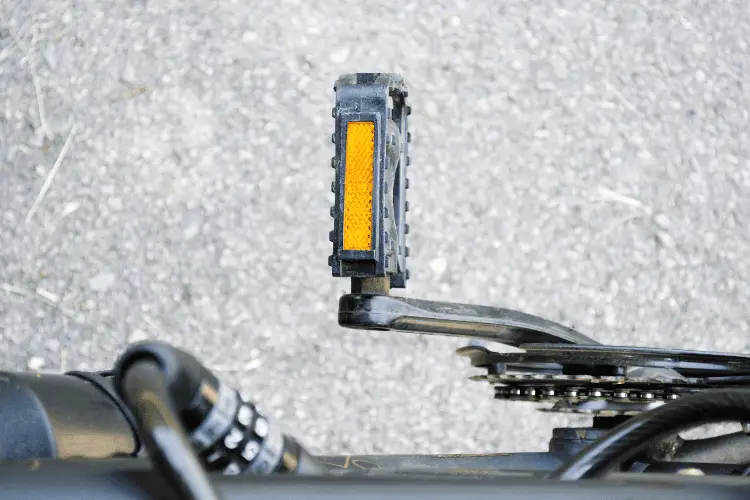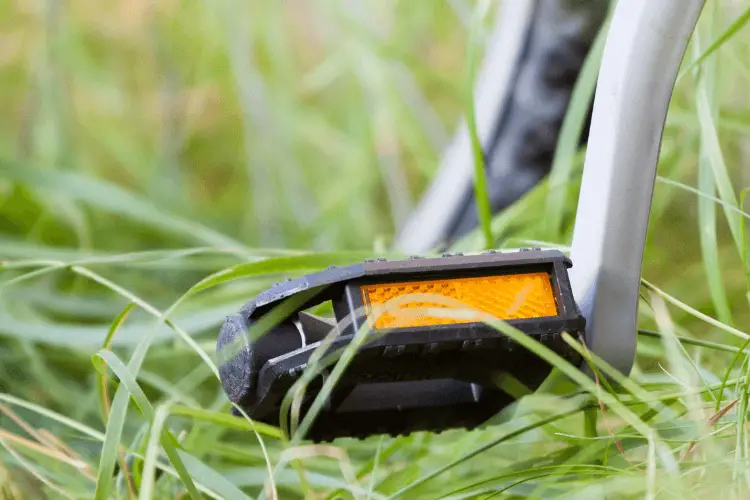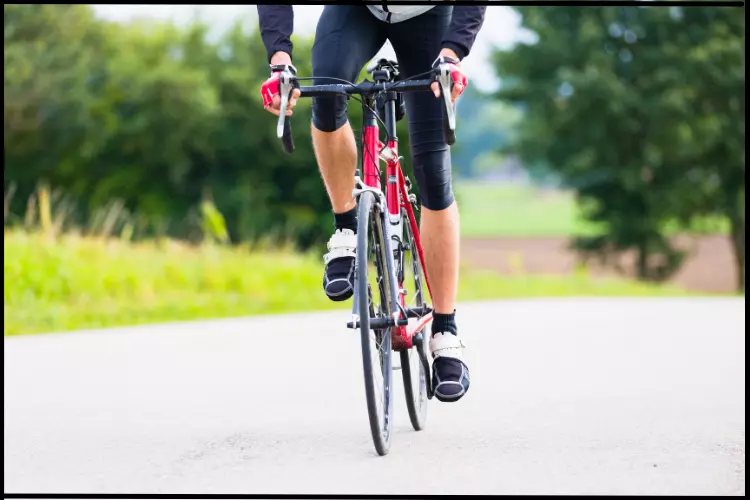The bike pedal becomes stiff due to excessive friction, or the bike is not in the correct gear. Using smaller gear or reducing friction can make the bike pedal feel less stiff. Friction is the result of worn-out brake pads, dry chain, or low tire pressure.
Stiff bike pedals are very common, but you should not take them lightly. To avoid getting in an accident, you should get a stiff pedal fixed as soon as possible. Delaying fixing stiff pedals can put you and your bike in harm’s way.
Don’t worry; I will tell you everything you need to know about stiff bike pedals. We will go over the main reasons why bike pedals become stiff, how to fix stiff pedals and how you can change the pedals of your bike.
At the end of this comprehensive guide, you will feel more confident riding your bike.
So, without further ado, let’s get to it.
Quick Navigation
Why is My Bike Pedal Stiff?
The pedals are connected directly or indirectly to many different mechanical components of the bike.

Therefore, stiffness in bike pedals can be due to several reasons.
Let’s go over the reasons for stiff bike pedals to identify your problem.
(i) Worn out Brake Pads
The brake pad has soft padding, which makes contact with the tires. Over time, this padding can deteriorate with use.
When the padding fully deteriorates, it leaves the bare metal behind. When you apply a bike’s brake, the metal directly interacts with the bike’s rim or disc.
This results in an increase in friction. The increased friction limits the rotation of your bike pedal, making it stiff. The brake pads are known to deteriorate in 500-1000 miles.
(ii) Rusty Pedals
Are you biking over trails with water? If so, then your pedals might have caught rust. Rust in the kryptonite of metallic parts.
When rust accumulates, it jams the pedal, making it stiff. Catching pedals with rust can be hard because it is a slow process.
(iii) Dry Chain
Your bike’s chain is essential for making the wheels spin. If the chain is not lubricated, it can result in increased friction.
As a result, this creates friction when pedaling because the power is not being transferred.
(iv) Wrong Fitment of Brakes and Tires
The bike’s brakes or tires may not be fitted properly. This can lead to drag and friction. As a result, the pedal feels stiff and heavy.
(v) Tight Brake Cable
The brake cable transfers tension when you pull the brake lever. It may become too tight if the brake cable has not been serviced. This will result in the tire resisting movement.
As a result, no matter how hard you pedal, the bike will not pick up speed. Ultimately, it will lead to the feeling of the bike pedal being too stiff.
(vi) Wrong gears for the terrain
Both low and high gears have their distinct uses. The low gear makes pedaling less difficult at the expense of reduced speed. Low gear is very beneficial for mountainous terrain.
High gear makes pedaling stiffer, but you can travel much faster. High gear is ideal for flat roads. The bike pedal will feel stiff if you use the wrong gear for the terrain.
(vii) Low Tire Pressure
Low tire pressure will cause more drag. The drag will increase the friction between the tire and the road surface. As a result, the bike’s pedals will feel stiffer compared to usual.
(viii) Wheel out of true
Wheel out of true results from misaligned tension in the bike’s spokes. When looked from behind, the wheel out of true will have an 8 pattern.
You can also identify it by the excessive wobble. Wheel out of true rubs against the brake pads, resulting in stiffer bike pedals.
How to Fix Stiff Pedals on a Bike?
Stiff pedals on a bike can be fixed by inflating the tire, lubing the chain, or adjusting the brake cable tension. Using the right gear for the terrain can also fix stiff bike pedals.

Let’s look at each of these fixes and some others in more detail. It will help you fix the stiff pedals of your bike.
(i) Keep the Chain Lubed
You can fix stiff bike pedals by lubricating the chain. When a chain is lubricated, it will not get stuck.
Therefore, you will get a smoother pedal feel. Before you lubricate the chain, make sure to clean it thoroughly.
(ii) Replace Brake Pads
Replace worn-out brake pads on your bike. Make sure the new brake pads you are getting are high-quality ones. If you do that, you won’t have to deal with stiff bike pedals anytime soon.
(iii) Loosen the Brake Cable
The fix to stiff bike pedals can sometimes be as simple as loosening the brake cable. You can either loosen the brake cable or take your bike to a local workshop.
(iv) Unjam the Bearing
The pedals are connected to a bearing. When the bearings seize, the pedals become stiff.
To unjam the bearing, use metallic grease. Ensure you don’t overdo the grease because the pedals might feel heavy.
(v) Inflate Tires to the Correct Pressure
Always keep your bike’s tire inflated to the correct pressure. The ideal pressure for your bike’s tire should be mentioned in the user manual. With this simple trick, you can fix stiff bike pedals in five minutes.
(vi) Don’t Rubbing Wheel and Tire
Anything rubbing against the tire or the wheel causes friction. It can also cause premature wear to the wire.
Therefore, ensure nothing is rubbing against the tire, and you should be good to go.
(vii) Use the Appropriate Gear
Using the appropriate gear for the terrain can fix the issue of stiff bike pedals. Switch to a low gear if you feel friction in the bike pedals. Low gear allows for easier pedaling.
(viii) Fix Wheel Out of True
The wheel out of true is calibrated by adjusting the spoke tension with a spoke key. This job is left to professionals. So, if you have this issue, take your bike to a workshop.
How to take off and Change Bike Pedals
Are your bike pedals stiff after trying all of the above fixes? If so, then you need to change your bike pedals.

The following is a guide on removing your previous bike pedals and installing new ones.
Prerequisites and Tools
Before proceeding to the process, gather the right tools.
You will need following tools :
- Pedal wrench
- an 8mm Allen key, and
- new pedals to change bike pedals.
Procedure :
- Starting on the non-driver side, take off the lower nut of the pedals with an 8mm Allen key. Make sure to unscrew in the clock direction.
- On the driver’s side, use the 8mm Allen key to remove the lower nut holding the pedal. Make sure to unscrew in an anticlockwise direction.
- After removing both nuts, the pedals should pop right out.
Since our old pedals are out, let’s install our new bike pedals.
- Put grease on the threads of the new pedals
- Screw in the driver-side pedal by turning the Allen key in a clockwise direction.
- Screw in the non-driver side pedal by turning the Allen key in an anti-clockwise direction.
Note: Some bike pedals don’t accept the Allen key. For this bike, you will need the specialized pedal wrench to unscrew the pedals from the crank.
Conclusion
Having stiff bike pedals is quite common. However, with the tips and tricks I gave in this article, you can say goodbye to this problem. Performing regular maintenance decreases the chances of your bike pedals becoming stiff.
So, ensure you stay up to date with the regular maintenance of your bike.
Whenever you experience stiff pedals, get them fixed as soon as possible. Slight negligence can lead to big accidents. Stay safe and ride in good health.

1 thought on “Why Is My Bike Pedal Stiff? (Ultimate Guide)”